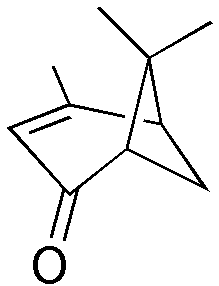Levoverbenone
 | |
| Clinical data | |
|---|---|
| ATC code | |
| Identifiers | |
| |
| CAS Number | |
| PubChem CID | |
| ChemSpider | |
| UNII | |
| ChEBI | |
| E number | {{#property:P628}} |
| ECHA InfoCard | {{#property:P2566}}Lua error in Module:EditAtWikidata at line 36: attempt to index field 'wikibase' (a nil value). |
| Chemical and physical data | |
| Formula | C10H14O |
| Molar mass | 150.218 g/mol |
| 3D model (JSmol) | |
| |
| |
| | |
|
WikiDoc Resources for Levoverbenone |
|
Articles |
|---|
|
Most recent articles on Levoverbenone Most cited articles on Levoverbenone |
|
Media |
|
Powerpoint slides on Levoverbenone |
|
Evidence Based Medicine |
|
Clinical Trials |
|
Ongoing Trials on Levoverbenone at Clinical Trials.gov Trial results on Levoverbenone Clinical Trials on Levoverbenone at Google
|
|
Guidelines / Policies / Govt |
|
US National Guidelines Clearinghouse on Levoverbenone NICE Guidance on Levoverbenone
|
|
Books |
|
News |
|
Commentary |
|
Definitions |
|
Patient Resources / Community |
|
Patient resources on Levoverbenone Discussion groups on Levoverbenone Patient Handouts on Levoverbenone Directions to Hospitals Treating Levoverbenone Risk calculators and risk factors for Levoverbenone
|
|
Healthcare Provider Resources |
|
Causes & Risk Factors for Levoverbenone |
|
Continuing Medical Education (CME) |
|
International |
|
|
|
Business |
|
Experimental / Informatics |
Editor-In-Chief: C. Michael Gibson, M.S., M.D. [1]
Overview
Levoverbenone is an expectorant. It is the L-isomer of verbenone.
Use of Levoverbenone for insect control
The southern pine beetle (Dendroctonus frontalis), a bark beetle, is a major threat to pine trees in the southeastern United States. Its reproductive cycle is controlled by varying ratios of certain natural chemicals, including verbenone. To reproduce, pine bark beetles aggregate in large numbers in their host pine trees. At the beginning of an attack, various chemicals produced by infested trees and by the beetles attract additional beetles of the same species. When the numbers of adults and larvae approach the maximum that the tree can support, antiaggregation signal chemicals, i.e., verbenone, are produced, reducing the likelihood that additional beetles will land and attack the tree. Forest managers frequently try to control infestations of the Southern pine bark beetle by cutting down and sometimes burning infested trees and nearby healthy trees. They then place verbenone formulations on nearby susceptible healthy trees to repel and confuse the beetles.[1]
Levoverbenone or (-)Verbenone is also used to manage mountain pine beetle (Dendroctonus ponderosae) infestations.[2] Verbenone is the principal antiaggregation pheromone of the mountain pine beetle, Dendroctonus ponderosae Hopkins, a notable forest insect capable of causing extensive levels of tree mortality in western North America. Although several formulations of verbenone have been registered with the U.S. Environmental Protection Agency [3] for tree protection, failures in efficacy are rather common. Unlike previous formulations, a new formulation of (–)-verbenone registered as SPLAT® Verb [4] (ISCA Technologies Inc., Riverside, CA) was found to be extremely efficient in protecting individual lodgepole pine, Pinus contorta Dougl. ex Loud., and small stands of P. contorta from mortality attributed to D. ponderosae. SPLAT® Verb applications resulted in complete individual P. contorta tree protection while 93.3% mortality occurred in the untreated controls; furthermore significantly fewer P. contorta were killed by D. ponderosae within 0.041-ha circular plots (11-m radius) surrounding P. contorta treated with SPLAT® Verb compared to the untreated control.[5]
References
- ↑ U.S. Environmental Protection Agency Pesticide Fact Sheet #128986.
- ↑ Mafra-Neto, Agenor; de Lame, Frédérique M.; Fettig, Christopher J.; Perring, Thomas M.; Stelinski, Lukasz L.; Stoltman, Lyndsie L.; Mafra, Leandro E. J.; Borges, Rafael; Vargas, Roger I. (2013). "Manipulation of Insect Behavior with Specialized Pheromone and Lure Application Technology (SPLAT®)". In John Beck, Joel Coats, Stephen Duke, and Marja Koivunen. Natural Products for Pest Management. 1141. American Chemical Society. pp. 31–58.
- ↑ U.S. Environmental Protection Agency Pesticide Fact Sheet #128986.
- ↑ SPLAT Verb Information Page http://www.iscatech.com/exec/SPLATVerbtest.html
- ↑ Mafra-Neto, Agenor; Fettig, Christopher J.; Munson, A.S.; Stelinski, Lukasz L. (2014). "The use of repellents formulated in Specialized Pheromone and Lure Application Technology (SPLAT®) for effective insect pest management.". In Debboun, M., S.P. Francis, and D.A. Strickman. Insect Repellents Handbook, Second Edition. Taylor & Francis, London. pp. 291–314.
- Pages with script errors
- CS1 maint: Multiple names: editors list
- Articles with changed EBI identifier
- E number from Wikidata
- ECHA InfoCard ID from Wikidata
- Chemical articles with unknown parameter in Infobox drug
- Chemical pages without DrugBank identifier
- Articles without KEGG source
- Drugs with no legal status
- Drugboxes which contain changes to verified fields
- Antitussives
- Ketones
- Alkenes
- Enantiopure drugs
- Monoterpenes
- Cycloalkenes